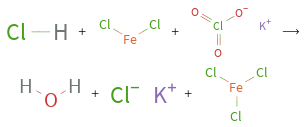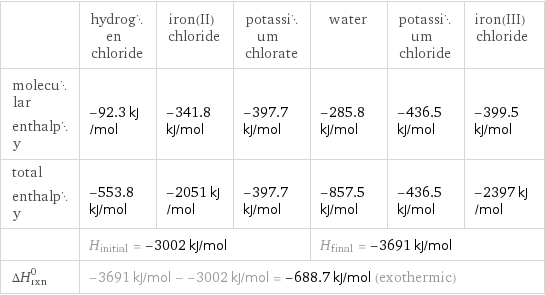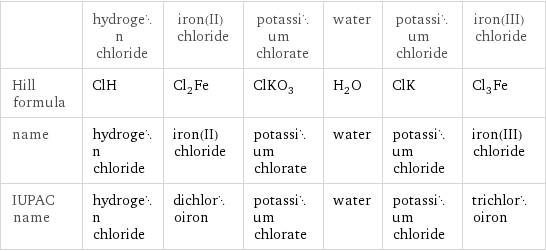Input interpretation

hydrogen chloride + iron(II) chloride + potassium chlorate ⟶ water + potassium chloride + iron(III) chloride
Balanced equation

Balance the chemical equation algebraically: + + ⟶ + + Add stoichiometric coefficients, c_i, to the reactants and products: c_1 + c_2 + c_3 ⟶ c_4 + c_5 + c_6 Set the number of atoms in the reactants equal to the number of atoms in the products for Cl, H, Fe, K and O: Cl: | c_1 + 2 c_2 + c_3 = c_5 + 3 c_6 H: | c_1 = 2 c_4 Fe: | c_2 = c_6 K: | c_3 = c_5 O: | 3 c_3 = c_4 Since the coefficients are relative quantities and underdetermined, choose a coefficient to set arbitrarily. To keep the coefficients small, the arbitrary value is ordinarily one. For instance, set c_3 = 1 and solve the system of equations for the remaining coefficients: c_1 = 6 c_2 = 6 c_3 = 1 c_4 = 3 c_5 = 1 c_6 = 6 Substitute the coefficients into the chemical reaction to obtain the balanced equation: Answer: | | 6 + 6 + ⟶ 3 + + 6
Structures

+ + ⟶ + +
Names

hydrogen chloride + iron(II) chloride + potassium chlorate ⟶ water + potassium chloride + iron(III) chloride
Reaction thermodynamics
Enthalpy

| hydrogen chloride | iron(II) chloride | potassium chlorate | water | potassium chloride | iron(III) chloride molecular enthalpy | -92.3 kJ/mol | -341.8 kJ/mol | -397.7 kJ/mol | -285.8 kJ/mol | -436.5 kJ/mol | -399.5 kJ/mol total enthalpy | -553.8 kJ/mol | -2051 kJ/mol | -397.7 kJ/mol | -857.5 kJ/mol | -436.5 kJ/mol | -2397 kJ/mol | H_initial = -3002 kJ/mol | | | H_final = -3691 kJ/mol | | ΔH_rxn^0 | -3691 kJ/mol - -3002 kJ/mol = -688.7 kJ/mol (exothermic) | | | | |
Gibbs free energy

| hydrogen chloride | iron(II) chloride | potassium chlorate | water | potassium chloride | iron(III) chloride molecular free energy | -95.3 kJ/mol | -302.3 kJ/mol | -296.3 kJ/mol | -237.1 kJ/mol | -408.5 kJ/mol | -334 kJ/mol total free energy | -571.8 kJ/mol | -1814 kJ/mol | -296.3 kJ/mol | -711.3 kJ/mol | -408.5 kJ/mol | -2004 kJ/mol | G_initial = -2682 kJ/mol | | | G_final = -3124 kJ/mol | | ΔG_rxn^0 | -3124 kJ/mol - -2682 kJ/mol = -441.9 kJ/mol (exergonic) | | | | |
Chemical names and formulas

| hydrogen chloride | iron(II) chloride | potassium chlorate | water | potassium chloride | iron(III) chloride Hill formula | ClH | Cl_2Fe | ClKO_3 | H_2O | ClK | Cl_3Fe name | hydrogen chloride | iron(II) chloride | potassium chlorate | water | potassium chloride | iron(III) chloride IUPAC name | hydrogen chloride | dichloroiron | potassium chlorate | water | potassium chloride | trichloroiron